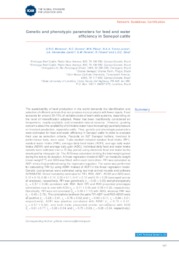Genetic and phenotypic parameters for feed and water efficiency in Senepol cattle.
Genetic and phenotypic parameters for feed and water efficiency in Senepol cattle.
Author(s): MENEZES, G. R. de O.; GOMES, R. da C.; RIBAS, M. N.; TORRES JUNIOR, R. A. de A.; FERNANDES JUNIOR, J. A.; PEREIRA, G. M.; FAVERO, R.; SILVA, L. O. C. da
Summary: The sustainability of beef production in the world demands the identification and selection of efficient animals that can produce more products with fewer inputs. Feed accounts for around 50-70% of variable costs of beef cattle systems, depending on the level of intensification adopted. Water has been traditionally considered an inexpensive, readily available, and renewable natural resource. However, growing concerns about the availability of drinkable water have increasingly pushed pressure on livestock production, especially cattle. Thus, genetic and phenotypic parameters were estimated for feed and water efficiency in Senepol cattle in order to evaluate their use as selection criteria. Records on 587 Senepol heifers, involved in performance tests, were used. Traits studied included residual feed intake (RFI), residual water intake (RWI), average daily feed intake (ADFI), average daily water intake (ADWI) and average daily gain (ADG). Individual daily feed and water intake records were collected over a 70-day period, using electronic feed and water bunks developed by Intergado Ltd. The ADG was calculated dividing the total weight gained during the test by its duration. A linear regression model of ADFI on metabolic weight (mean weight 0.75 ) and ADG was fitted, within each test edition. RFI was calculated as ADFI minus that predicted using the regression equation. The same was performed for calculating RWI by using ADWI instead of ADFI in the linear regression model.
Publication year: 2018
Types of publication: Paper in annals and proceedings
Unit: Embrapa Beef Cattle
Keywords: Beef, Correlation, Heritability, Residual feed intake, Residual water intake, Selection
Observation
Some of Embrapa's publications are published as ePub files. To read them, use or download one of the following free software options to your computer or mobile device. Android: Google Play Books; IOS: iBooks; Windows and Linux: Calibre.
Access other publications
Access the Agricultural Research Database (BDPA) to consult Embrapa's full library collection and records.
Visit Embrapa Bookstore to purchase books and other publications sold by Embrapa.

